This time-lapse video of the 2008 Inakadate rice crop art is composed of still images captured daily from June 1 to July 3, 2008 via the roof webcam at the adjacent town hall. The 3.7-acre work features the images of Daikoku, god of wealth (left), and Ebisu, god of fishers and merchants (right), which were created using five different colors of rice plants. On July 4, just as the crop was beginning to mature, the organizers shut down the webcam when they removed the JAL ad portion of the artwork at the request of the rice paddy owner.
Monster octopi with scores of extra tentacles
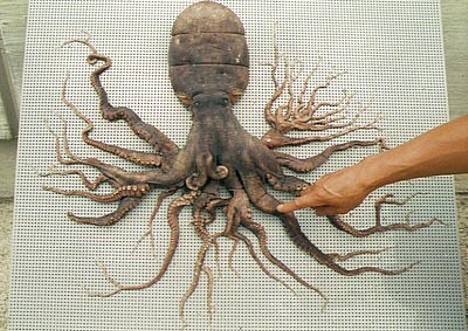
In nature, it is quite rare to encounter octopi with extra tentacles (or "arms," for the purists), but a pair of aquariums in Japan's Mie prefecture have some extraordinary specimens on hand.
The permanent display at the Shima Marineland Aquarium in the town of Shima includes a 96-tentacled Common Octopus (Octopus vulgaris) that weighed 3.3 kilograms (about 7 lbs) and measured 90 centimeters (3 ft) long when it was captured in nearby Matoya Bay in December 1998. Before dying 5 months later, the creature laid eggs, making it the first known extra-tentacled octopus to do so in captivity. All the baby octopi hatched with the normal number of tentacles, but unfortunately they only survived a month.
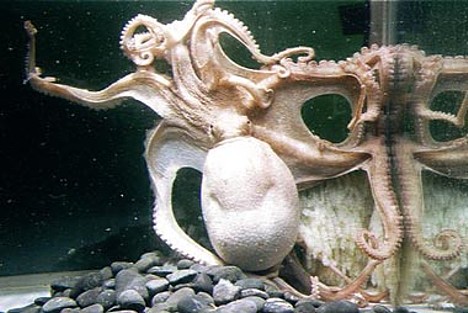
96-tentacled octopus laying eggs
The preserved octopus actually has the normal number of 8 appendages attached to its body, but each one branches out to form the multitude of extra tentacles. Apparently there is no theory that fully explains the surplus tentacles, but they are believed to be the result of abnormal regeneration that occurred after the octopus suffered some sort of injury.
* * * * *
The Toba Aquarium in the nearby town of Toba also has a few extraordinary octopus specimens, although they no longer appear to be on permanent display. Every now and then, though, the aquarium pulls them out of storage for the world to see.
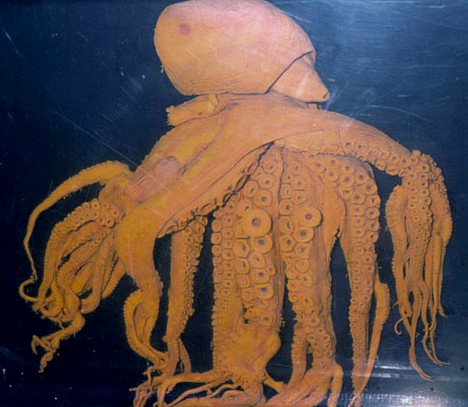
85-tentacled octopus at Toba Aquarium
Their most well-known specimen is an 85-tentacled Common Octopus captured in 1957 at nearby Toshijima island. This remarkable creature -- which, like the Shima Marineland octopus, has 8 main arms that branch out to form scores of tentacles -- made quite a stir when it first went on display at Toba Aquarium a half-century ago. A few years later, the specimen was loaned to the National Museum of Nature and Science in Tokyo, where it famously caught the attention of the Showa Emperor.
The renowned creature eventually returned to Toba and went on permanent display until the aquarium moved to a new location in 1985, at which time it was placed in storage. Twenty years later, in 2005, the specimen entered the spotlight again when it was put on temporary display.
In the 50 years since the 85-tentacled octopus was captured, the Toba Aquarium has exhibited 6 other mutant octopi, most of them alive for a time, and each with between 9 and 56 tentacles.
[Related: Photo: Nine-tentacled octopus]
Emperor analyzes tanuki dung in name of science

When not carrying out his official duties as monarch of Japan, Emperor Akihito takes a deep interest in scientific research. A keen ichthyologist, the Emperor has published dozens of scientific papers on members of the goby family, and his work is so well known that the recent discoverers of a new goby species (Exyrias akihito) named their fish after him.
But while most of the Emperor's past work has focused on gobies, his latest research investigates the feeding habits of wild tanuki -- also known as raccoon dogs (Nyctereutes procyonoides) -- that inhabit the spacious grounds of the Imperial Palace in Tokyo.
The research, which was published in the Bulletin of the National Museum of Nature and Science in June, involved the analysis of tanuki dung samples collected from the Imperial Palace grounds between April 2006 and December 2007. In all, 169 samples were collected from 30 "dung accumulation sites" (apparently, tanuki have certain preferred locations they use again and again). The samples were inspected for remnants of undigested materials that revealed the tanuki's feeding habits and seasonal changes in diet. At his own request, the Emperor performed the dirty work himself.
The Emperor's findings, which were written with the assistance of four researchers from the National Museum of Nature and Science, suggest that the tanuki inhabiting the forested area around the Imperial Palace feed heavily on nuts, insects (especially ground beetles) and birds -- unlike their suburban cousins who subsist on a steady diet of human garbage.
Animalistic digital art by Ryohei Hase
These computer-generated illustrations of feral animal-headed people are from Ryohei Hase's collection of digital art (NSFW).

battle

Go forward and forward

Child's Mind
Also visit his deviantArt gallery for hi-res versions of these and other works.
[Via: Drawn!]
Video: ‘Daruma-otoshi’ skyscraper demolition

Japanese construction firm Kajima Corporation is using an innovative new skyscraper demolition method to dismantle a pair of old company buildings in Tokyo. (Watch a time-lapse video.)
Unlike conventional demolition that begins at the top of the building, Kajima's new method starts on the bottom floor, where the support columns are cut and replaced with giant computer-controlled jacks. Once the floor is demolished and the debris removed, the entire building is lowered and work begins on the next floor. The process is repeated for each floor until the entire building is gone.
Kajima informally calls this the daruma-otoshi method, after the old Japanese game consisting of a daruma doll made of stacked pieces that players knock out one by one without toppling the doll. (Watch a super slo-mo video.)
According to Kajima, the daruma-otoshi demolition method -- which is now being used to dismantle a 75 meter (246 ft) tall, 20-story building and a 65 meter (213 ft) tall, 17-story building -- is safer and creates less noise and dust pollution because the work is kept close to the ground. In addition, this method cuts demolition time by 20% and makes it easier to separate and recycle the building materials.
[Link: Kajima]
Remote-control shopping robot
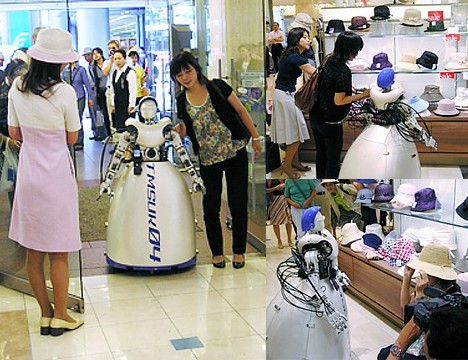
Robot developer tmsuk has unveiled a remote-control robot that promises a new way to shop from the comfort of home. A prototype of the telerobotic shopper -- a modified TMSUK-4 humanoid robot that incorporates a variety of cellphone communications technology -- was demonstrated on July 10 at the Izutsuya department store in the city of Kitakyushu, Japan.
In the demonstration, an unwell grandmother unable to go shopping with her granddaughter sent the robot in her place. Using an NTT DoCoMo video-capable cellphone, the grandmother was able to control the robot and enjoy the shopping experience through the robot's camera eyes. As curious shoppers looked on, the woman maneuvered the robot to the hat section, eyed what was available on the shelf, and had her granddaughter model a few for her before deciding which one to purchase.
According to tmsuk, this innovative type of "3D communications" technology brings us a step closer to a future in which telerobotic shoppers roam the fashionable areas of cities like New York or London.
[Source: Data Max]
Floodgates
Photographer Sato Jun Ichi explores the architecture of Japan's flood control infrastructure in a huge collection of photographs taken over a period of 10+ years.
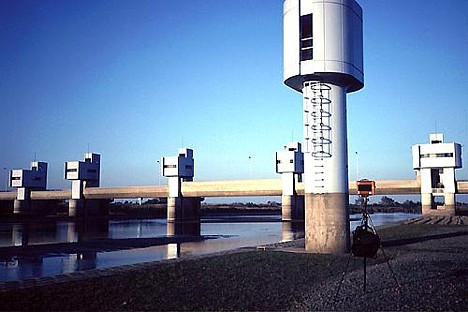
Ibaraki, 1997
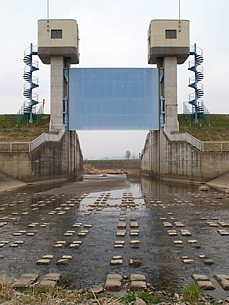
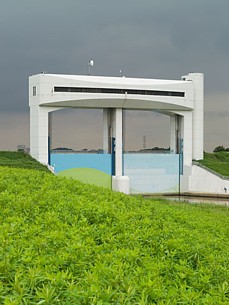
Tochigi, 2006 // Saitama, 2007

Saitama, 1999

Chiba, 1997
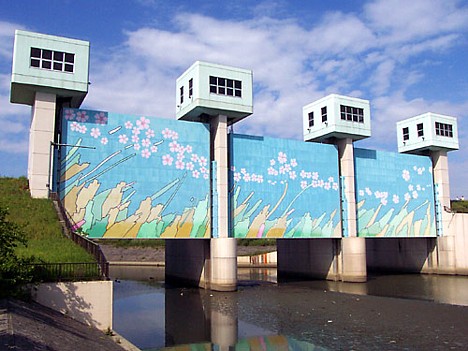
Saitama, 1999

Saitama, 2006
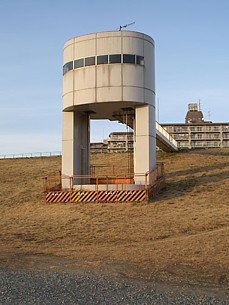
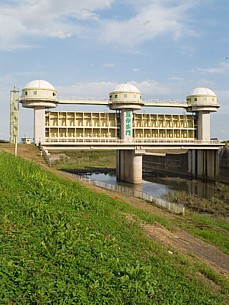
Saitama, 2006 // Saitama, 2007
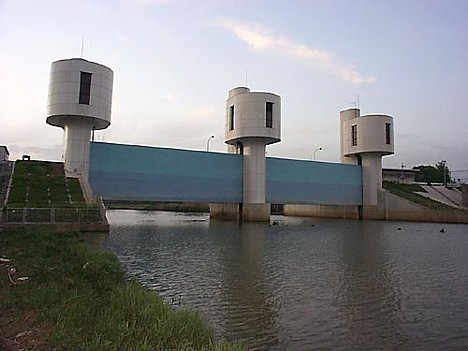
Ibaraki, 1998

Saitama, 1998
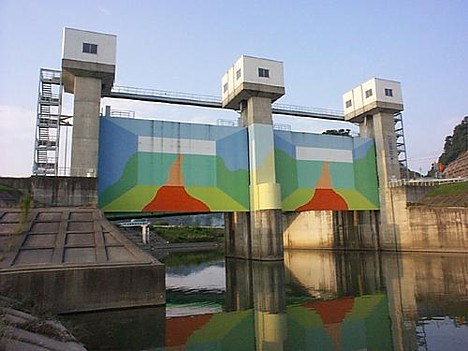
Miyagi, 1998
Visit Sato's Floodgates site for about 600 more photos. (Use the links at the top left to scroll through the 37 galleries.) There is also a book.
Photo: JAL logo still visible in crop art
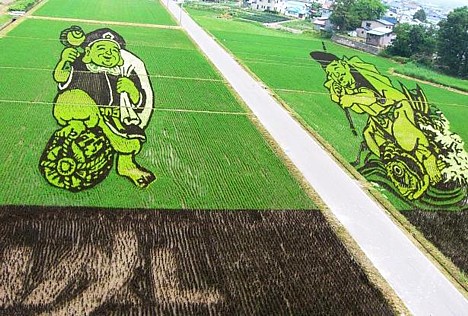
This photo snapped by Aomori-based blogger Pochiko shows remnants of the JAL logo still visible in this year's Inakadate rice paddy art, several days after organizers attempted to "erase" it.
Read more: JAL logo uprooted from rice paddy art
Yen portraits fool age-verification cameras
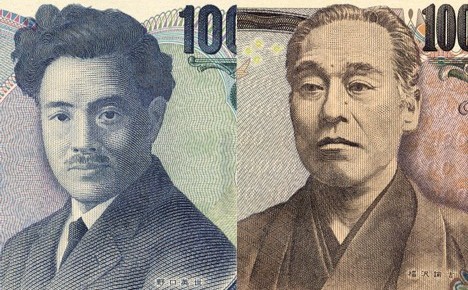
Do these fellows look old enough to smoke? Yes indeed, say Japan's cigarette vending machines that use face-recognition technology to determine the age of the purchaser.
Just two weeks after a major sports paper reported that magazine photos could be used to fool vending machine age-verification cameras, an even more surprising flaw has come to light. The portraits of Hideyo Noguchi and Yukichi Fukuzawa printed on the 1,000-yen and 10,000-yen bills can be used to trick the high-tech machines, according to a new report on the Sankei Shimbun website.
On July 1 -- the day that Japan's cigarette vending machine age-verification system was rolled out nationwide -- Sankei reporters in Tokyo went out in search of machines equipped with age-verification cameras. They found that these machines treated them as adults and allowed them to purchase cigarettes when they showed the portrait of Yukichi Fukuzawa (the renaissance man and Keio University founder who appears on the 10,000-yen note) to the vending machine's camera-embedded mirror. The machines also reportedly sold cigarettes to the portrait of Hideyo Noguchi (the notable bacteriologist who discoveredcontributed to the understanding of syphilis), which appears on the 1,000-yen note.
Once the machines approved the sale, the reporters then used the same money to pay for the purchase, making this all-in-one technique even more convenient than the recently discovered magazine photo trick.
Ironically, news of this latest discovery comes just days after the Finance Ministry officially approved the use of face-recognition technology to determine the age of vending machine users.
Sankei contacted the Finance Ministry's Tobacco and Salt Industries Office about the flaw they found. A surprised official responded by saying, "This is the first we've heard of it. It's a big problem if it's true."
The official said he would immediately notify Fujitaka, the vending machine manufacturer who developed the age-verification camera system. Fujitaka is reportedly in the process of upgrading its face-recognition technology so that it can more effectively distinguish photographs from real people.
Of Japan's more than 500,000 cigarette vending machines, around 4,800 (less than 1%) are equipped with age-verification cameras. The rest are outfitted with readers that check Taspo age-verification cards, which are available to anyone of legal age who applies (though they have yet to become widespread). The vending machines that use age-verification cameras allow people to purchase cigarettes without a Taspo card, as long as they look older than 20 years of age.
[Source: Sankei Shimbun]
